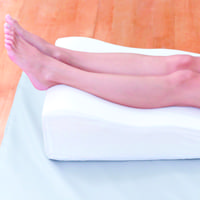So much of pregnancy is so cute—fun maternity tops, the glow in your cheeks and decorating your baby’s nursery. So, what’s with the big, bulging blueish lines emerging on your legs? There’s just nothing cute about that at all.
You’re So Vein
Welcome the not-so-cute pregnancy discomfort that some 1 in 3 pregnant women experience: varicose veins. In pregnancy, increased blood volume puts extra pressure on your blood vessels, especially the veins in your legs, which have to work against gravity to push all that extra blood back up to your heart.
Veins have valves that stop the blood that is returning to your heart from flowing backwards. When valves are not working properly, blood collects in weakened areas.
What you see—and experts call varicose veins—can be blue, red, or flesh-colored. They often look like cords, appearing twisted and bulging. They can be swollen and raised above the surface of the skin. They’re uncomfortable and for some, even itchy or painful. But they’re typically not harmful to you or your baby.
Varicose veins most often appear on your thighs, backs of your calves, or the inside of your leg. They are most often in the legs but can also be in around the vagina, vulva or buttocks.
Are You At Risk?
If a family member—say your mom or an aunt—has varicose veins, you’re more likely to develop them too. The hormone progesterone relaxes your veins in pregnancy to accommodate the extra blood volume, increasing your risk. If you’re overweight or obese, you’re putting extra pressure on your veins and legs, increasing risk. If you’re prone to sitting or standing for long periods of time, you’re more likely to develop them—vary your position and put your legs up when resting.
Reduce Your Risks; Ease Discomfort
Varicose veins aren’t always preventable—half of all people ages 50+ (especially women) have them—but you can be proactive about preventing them or easing their discomfort if present:
- Don’t cross your legs for long periods of time when sitting.
- Wear loose, well-fitting clothes: Don’t wear clothes that constrict your waist or bind your legs, including your underwear.
- Maintain a healthy weight—excess weight increases pressure on your legs and your veins.
- Elevate your legs when resting as much as possible.
- Don’t stand or sit for long periods of time.
- Exercise regularly to improve your leg strength, circulation, and vein strength. Regularly run or walk to keep your circulation moving.
- Wear support stockings.






Comments are closed.